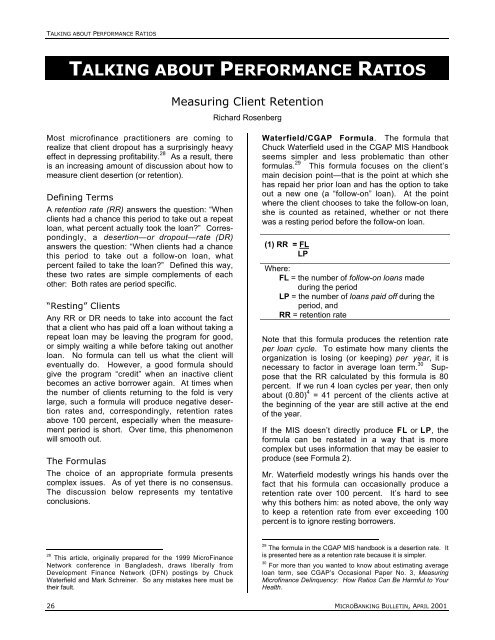the microbanking bulletin - Microfinance Information Exchange
the microbanking bulletin - Microfinance Information Exchange
the microbanking bulletin - Microfinance Information Exchange
Create successful ePaper yourself
Turn your PDF publications into a flip-book with our unique Google optimized e-Paper software.
TALKING ABOUT PERFORMANCE RATIOSTALKING ABOUT PERFORMANCE RATIOSMeasuring Client RetentionRichard RosenbergMost microfinance practitioners are coming torealize that client dropout has a surprisingly heavyeffect in depressing profitability. 28 As a result, <strong>the</strong>reis an increasing amount of discussion about how tomeasure client desertion (or retention).Defining TermsA retention rate (RR) answers <strong>the</strong> question: “Whenclients had a chance this period to take out a repeatloan, what percent actually took <strong>the</strong> loan?” Correspondingly,a desertion—or dropout—rate (DR)answers <strong>the</strong> question: “When clients had a chancethis period to take out a follow-on loan, whatpercent failed to take <strong>the</strong> loan?” Defined this way,<strong>the</strong>se two rates are simple complements of eacho<strong>the</strong>r: Both rates are period specific.“Resting” ClientsAny RR or DR needs to take into account <strong>the</strong> factthat a client who has paid off a loan without taking arepeat loan may be leaving <strong>the</strong> program for good,or simply waiting a while before taking out ano<strong>the</strong>rloan. No formula can tell us what <strong>the</strong> client willeventually do. However, a good formula shouldgive <strong>the</strong> program “credit” when an inactive clientbecomes an active borrower again. At times when<strong>the</strong> number of clients returning to <strong>the</strong> fold is verylarge, such a formula will produce negative desertionrates and, correspondingly, retention ratesabove 100 percent, especially when <strong>the</strong> measurementperiod is short. Over time, this phenomenonwill smooth out.The FormulasThe choice of an appropriate formula presentscomplex issues. As of yet <strong>the</strong>re is no consensus.The discussion below represents my tentativeconclusions.Waterfield/CGAP Formula. The formula thatChuck Waterfield used in <strong>the</strong> CGAP MIS Handbookseems simpler and less problematic than o<strong>the</strong>rformulas. 29 This formula focuses on <strong>the</strong> client’smain decision point—that is <strong>the</strong> point at which shehas repaid her prior loan and has <strong>the</strong> option to takeout a new one (a “follow-on” loan). At <strong>the</strong> pointwhere <strong>the</strong> client chooses to take <strong>the</strong> follow-on loan,she is counted as retained, whe<strong>the</strong>r or not <strong>the</strong>rewas a resting period before <strong>the</strong> follow-on loan.(1) RR = FLLPWhere:FL = <strong>the</strong> number of follow-on loans madeduring <strong>the</strong> periodLP = <strong>the</strong> number of loans paid off during <strong>the</strong>period, andRR = retention rateNote that this formula produces <strong>the</strong> retention rateper loan cycle. To estimate how many clients <strong>the</strong>organization is losing (or keeping) per year, it isnecessary to factor in average loan term. 30 Supposethat <strong>the</strong> RR calculated by this formula is 80percent. If we run 4 loan cycles per year, <strong>the</strong>n onlyabout (0.80) 4 = 41 percent of <strong>the</strong> clients active at<strong>the</strong> beginning of <strong>the</strong> year are still active at <strong>the</strong> endof <strong>the</strong> year.If <strong>the</strong> MIS doesn’t directly produce FL or LP, <strong>the</strong>formula can be restated in a way that is morecomplex but uses information that may be easier toproduce (see Formula 2).Mr. Waterfield modestly wrings his hands over <strong>the</strong>fact that his formula can occasionally produce aretention rate over 100 percent. It’s hard to seewhy this bo<strong>the</strong>rs him: as noted above, <strong>the</strong> only wayto keep a retention rate from ever exceeding 100percent is to ignore resting borrowers.28This article, originally prepared for <strong>the</strong> 1999 MicroFinanceNetwork conference in Bangladesh, draws liberally fromDevelopment Finance Network (DFN) postings by ChuckWaterfield and Mark Schreiner. So any mistakes here must be<strong>the</strong>ir fault.29 The formula in <strong>the</strong> CGAP MIS handbook is a desertion rate. Itis presented here as a retention rate because it is simpler.30For more than you wanted to know about estimating averageloan term, see CGAP’s Occasional Paper No. 3, Measuring<strong>Microfinance</strong> Delinquency: How Ratios Can Be Harmful to YourHealth.26 MICROBANKING BULLETIN, APRIL 2001
















